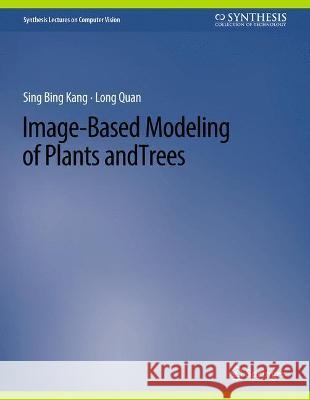Image-Based Modeling of Plants and Trees » książka
Image-Based Modeling of Plants and Trees
ISBN-13: 9783031006807 / Angielski / Miękka / 2009 / 74 str.
Plants and trees are among the most complex natural objects. Much work has been done attempting to model them, with varying degrees of success. In this book, we review the various approaches in computer graphics, which we categorize as rule-based, image-based, and sketch-based methods. We describe our approaches for modeling plants and trees using images. Image-based approaches have the distinct advantage that the resulting model inherits the realistic shape and complexity of a real plant or tree. We use different techniques for modeling plants (with relatively large leaves) and trees (with relatively small leaves).With plants, we model each leaf from images, while for trees, the leaves are only approximated due to their small size and large number. Both techniques start with the same initial step of structure from motion on multiple images of the plant or tree that is to be modeled. For our plant modeling system, because we need to model the individual leaves, these leaves need to be segmented out from the images. We designed our plant modeling system to be interactive, automating the process of shape recovery while relying on the user to provide simple hints on segmentation. Segmentation is performed in both image and 3D spaces, allowing the user to easily visualize its effect immediately. Using the segmented image and 3D data, the geometry of each leaf is then automatically recovered from the multiple views by fitting a deformable leaf model. Our system also allows the user to easily reconstruct branches in a similar manner. To model trees, because of the large leaf count, small image footprint, and widespread occlusions, we do not model the leaves exactly as we do for plants. Instead, we populate the tree with leaf replicas from segmented source images to reconstruct the overall tree shape. In addition, we use the shape patterns of visible branches to predict those of obscured branches. As a result, we are able to design our tree modeling system so as to minimize user intervention. We also handle the special case of modeling a tree from only a single image. Here, the user is required to draw strokes on the image to indicate the tree crown (so that the leaf region is approximately known) and to refine the recovery of branches. As before, we concatenate the shape patterns from a library to generate the 3D shape. To substantiate the effectiveness of our systems, we show realistic reconstructions of a variety of plants and trees from images. Finally, we offer our thoughts on improving our systems and on the remaining challenges associated with plant and tree modeling. Table of Contents: Introduction / Review of Plant and Tree Modeling Techniques / Image-Based Technique for Modeling Plants / Image-Based Technique for Modeling Trees / Single Image Tree Modeling / Summary and Concluding Remarks / Acknowledgments











